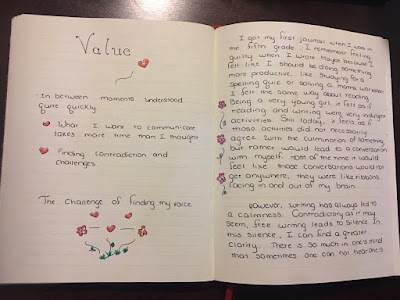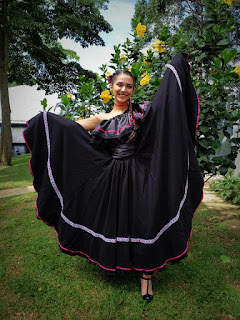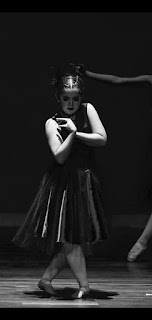Costa Rican Folklore
Folklore and Creative Movement Dance Teacher
Valeria Chavarria during her formative years.
As a dance and early childhood educator, the importance of Costa
Rican folklore dance as a formative part of the child’s experience is
undeniable from both research and field observation perspectives.
From a dance education perspective, for the Costa Rican child
in the early years, folklore dance is an important part of an embodied
education rendering national and cultural experience since early childhood.
Through the rite of passage of dressing in typical attire, dancing
to folklore music, and following traditional choreography, the Costa Rican child
steps into the dancing feet of generations of Costa Ricans who danced before . Through
the dance experience, Costa Rican children capture their shared historic
identity.
From a socio-affective perspective, Costa Rican dance offers a
collective and enthusiastic experience through the guttural awakening of
musical passion shared in a group dance.
Furthermore, in moments of national unrest, democratic questioning
of identity and patriotic crisis, as will exist in contemporary and future
history: folklore dance allows a common, peaceful search of this common
identity found in the silence of the dancer in the rhythmic nature of
collective dance. Costa Rican children that dance together will find further
social interactions less challenging and more natural. Costa Rican folklore
dance is danced in groups, and usually paired up with a dance partner.
From a developmental experience for preschool children, the
complexity of the gross motor experience is extraordinary. The chorographic
patterns of folklore dance organise its dancers in geometric patterns such as
circles, diagonals and lines. Dancers will dance side by side and at
times will mirror each other. The nature of such movement leads to great
challenges to children in the early years that are working on development of laterality,
maturity of their vestibular system, and proprioception (Connell and McCarthy,
2014). Folklore dance choreography through its patterns and movement, provide
experiences that allow the brain to explore such challenges through the
body. Through the physical challenges of
Costa Rican folklore dance, early years students will explore body and spatial
awareness, developing a sense of body subconscious.
Costa Rican Preschool Amazonas Typical Dance.
Jethro Desanti in his early childhood. Dancing in pairs.
From a historic perspective, Costa Rican folklore dance reunites
national mixed cultural heritage. Appreciating folklore dance at national
patriotic celebrations, the audience will see a variety of female dancers with
a variety of colourful dresses with flower and lace depending on the province
represented, and gentlemen with hats or countrymen attire for the male dancers.
Folklore Dancer and Dance Teacher Valeria Chavarria
Folklore Dancer and Dance Teacher
Valeria Chavarria
Male campesino typical dress.
Jethro Desanti Preschool years
Folklore dance is lively and light on the dancer’s feet.
Dancing on a low demi point, on the balls of the feet or flat footed,
wearing sandals or leather shoes. Long necks and strong backs
characterize a fluid and soft dance. The
music represents different cultural and historic moments, musical groups from
pre-colonial, colonial and mixed-immigrant heritage. The
instruments range from the marimba to the guitar, often accompanied with
singing to the folkloric dance (Molina and Palmer, 2011).
Folklore dance teacher Valeria Chavarria is a young dancer and
dance teacher of folklore and creative movement dance for preschool and
elementary school children in both public and private schools in Costa
Rica. With eleven years’ experience in
folklore dance, she was a great participant for this research study and was generous
to lend her time for an interview.
Valeria was a folklore dancer for the troupe Batsú Folkloric Projection. She represented Costa Rican folklore dance
both nationally and internationally.
Folklore Dancer and Dance Teacher
Valeria Chavarria and Dancer Dylan Alvarado Fernandez
From her international dance experience, she analyses that
contemplating the work of international dance troupes, some countries held
their folklore dance to extraordinary high esteem. She further
questioned, “why not us?”
Valeria further explained, “the richness of folklore dance escapes
most Costa Ricans, the details of dance style, clothing garments and musical
interpretation vary greatly from one province to another. There is so
much to learn still.”
Demonstrating such diverse complexity:
Costa Rican Folklore
Folklore and Creative Movement Dance Teacher
Valeria Chavarria during her formative years.
Costa Rican Folklore
Folklore and Creative Movement Dance Teacher
Valeria Chavarria during her formative years.
Costa Rican Folklore
Folklore and Creative Movement Dance Teacher
Valeria Chavarria during her formative years.
Costa Rican Indigineous Folklore
Folklore and Creative Movement Dance Teacher
Valeria Chavarria during her formative years
Regarding cultural identity and national pride, she insisted once
again, “Why is it that in Costa Rica we are not proud as dancers are in other
countries of their folklore?” Her pedagogical vision is of extending and democratising the dance experience for all students. Thus, allowing the student to gain further
cultural appreciation and hands on learning into their own dance traditions and
complex national identity.
Valeria suspects that our identity as a developing nation and
former Spanish colony weakens our self-image as a nation as we yearn for the
commodities and stability of modern, globalised society. Perhaps she is
right, in our quest to seek to progress and become citizens of the world we may
forget to look back and understand our roots and cultural grounding.
Yet perhaps, as Valeria believes, greater exposure and experience
of Costa Rican dance in all its richness and complexity could lead to prouder
Costa Ricans. Costa Ricans with greater sensitivity
of the cultural complexity that informs our history and shapes our modernity.
Rethinking Valeria’s words and appreciating the great pride of the
international community for folklore, and of the need for cultural awareness
and uniqueness in an increasingly homogeneous international community as
nations struggle to conform but at the same time seek nationalism, one wonders
indeed: Why not us? Why not greater folklore
dance education in our Costa Rican preschools and schools? Why not, indeed?
About Valeria Chavarria
Folklore Dancer and Dance Teacher
 During
my school years, I was part of a group of typical Costa Rican Folklore called Batsù Folkloric Projection. Over the years I also trained in Ballet, Jazz, Hip Hop,
Latin Rhythms and Ballroom.
During
my school years, I was part of a group of typical Costa Rican Folklore called Batsù Folkloric Projection. Over the years I also trained in Ballet, Jazz, Hip Hop,
Latin Rhythms and Ballroom.
I have attended
several national and international art festivals such as the “Festicers Les
Enfants du Monde” in France and the FEA in Costa Rica, also dance competitions,
congresses and presentations in various theatres in our country.
My goal is to bring art to as many
children and young people as possible, teach them that through music and dance
people can acquire discipline and motivation; they can express different
feelings and above all, show them that they can, in a physical and mental way,
develop many skills. It would be a tool from which they can balance their lives
and find a way to cope with difficult situations.
-Valeria


































